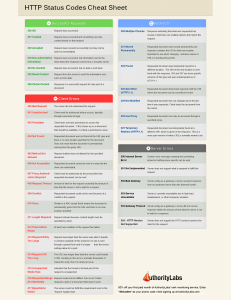
One of the most important parts of a successful website is how that site responds to requests. Everything may look good in your browser, but unless you know what response code those pages are sending back, it may not matter how good it looks. I have seen sites that show pages that look right on the surface but somehow the CMS they are using is responding with a 404, which is telling the visitor that the document wasn’t found. That’s a bad idea and a good way to lose all of your search traffic. I always check the status codes for a site I’m working on to make sure there aren’t unseen issues. One great tool for checking the response is URI Valet.
We have compiled a list of response codes that you should probably at least have a brief understanding of.
Successful Requests
200 OK – Request was successful.
201 Created – Request was successful and something new was created based on that request.
202 Accepted – Request was received successfully, but may not be acted on immediately.
203 Non-authoritative Information – Request was successful, but information sent to the client about the response comes from a 3rd party server.
204 No Content – Request was successful, but no data is sent back.
205 Reset Content – Request from the server to reset the information sent, such as form data.
206 Partial Content – Response to a successful request for only part of a document.
Redirects
300 Multiple Choices – Response indicating that what was requested has moved or that there are multiple options that match the request.
301 Moved Permanently – Requested document was moved permanently and response contains the URI for that new location. Important to use when changing domains names or URLs of existing documents.
302 Found – Requested document was temporarily moved to a different location. The URI of the new location is sent back with the response. 303 and 307 are more specific versions of this type and were implemented as of HTTP/1.1.
303 See Other (HTTP/1.1) – Requested document found and responds with the URI where the document can be currently be found.
304 Not Modified – Requested document has not changed since the last time it was requested. Client loads the document from the cache.
305 Use Proxy – Requested document can only be accessed through a specified proxy.
307 Temporary Redirect (HTTP/1.1) – Requested document can temporarily found at a different URI, which is given in the response. This is a more pure version of what a 302 is normally meant to be.
Client Errors
400 Bad Request – The server did not understand the request.
401 Unauthorized – Client must be authorized before access, typically through some kind of login.
403 Forbidden – Client does not have permission to access the requested document. If this shows up on a document that should be available, it is likely a permissions issue.
404 Not Found – Requested document was not found at the URL give and there is no new location specified for the document. Does not mean that the document is permanently missing from the given URL.
405 Method Not Allowed – Request method was not allowed for the specified document.
406 Not Acceptable – Requested document cannot be sent in a way that the client can understand.
407 Proxy Authentication Required – Client must be authorized by the proxy before the requested document can be sent.
408 Request Timeout – Amount of time for the request exceeded the amount of time that the server is set to wait for a request.
409 Conflict – Requested document could not be sent because of a conflict in the request.
410 Gone – Similar to a 404, except that it means the document is permanently gone from the URL and there is no new location specified.
411 Length Required – Request refused because content length must be specified by client.
412 Precondition Failed – At least one condition of the request has failed.
413 Request Entity Too Large – Request was larger than the server was able to handle. A common example of this would be if a file is sent through a posted form and it is larger than the server settings allow for a post.
414 Request URI Too Long – The URL was longer than what the server could handle. A URL resulting in this error is normally thousands of characters long, thus it is rarely an issue.
415 Unsupported Media Type – Indicates that the format of at least part of the request is unsupported.
416 Requested Range Not Satisfiable – Request could not be fulfilled. Can occur if client requests a part of a document that doesn’t exist.
417 Expectation Failed – The server could not fulfill the requirements sent in the “Expect” header field.
Server Errors
500 Internal Server Error – Generic error message meaning that something broke but nothing more specific can be sent.
501 Not Implemented – Server does not support what is required to fulfill the request.
502 Bad Gateway – Server acting as a gateway or proxy received response from an upstream server that was deemed invalid.
503 Service Unavailable – Server is currently unavailable due to high load, maintenance, or other temporary situation.
504 Gateway Timeout – Server acting as a gateway or proxy did not receive response within the amount of time that the server is set to wait for a response.
505 HTTP Version Not Supported – Server does not support the HTTP protocol used by the client for the request.